Character Design
On this page you find some thoughts on character design using puppetry as example for some aspects. There is more on puppetry and puppet building on another page. If you want me to help you with figure or story development for your project, get in touch to discuss needs, conditions, and options!
Character Design is central for telling stories - you cannot tell a story without having objects or figures act in specific - characteristic - ways. It does not matter whether these ways of behaviour are in line with expectations, i.e. whether they are typical or even stereotypical or whether they differ from expectations.
All kinds of narrative contexts ask for figures that are detailed enough so that they are believable and convincing in their specific context. Very different routines exist on how to develop figures far enough, so that they work well or even get a live of their own (kind of). In acting, some people imagine and develop background stories for the characters they play, so that thy can fill them with individual mottivation and induviduality (method acting goes much further, obviously - how one does method acting on theatre stages while switching between different plays on alternating days, I have no clue). Anyway: figures benefit from backstories and differentiated ways of behaviour etc. Striking examples are avatars in games that only make sense to be played because of the narrative diversion and personal investment of thoughts on individual abilities, inabilities, ticks, and traits. In Role Playing Games you cannot even play properly if you have not developed your figure in detail so that you have something to set against the behaviour of other players (for a more detailed discussion see my booklet on Schlaraffia that looks in detail into the development of chivalric avatars in that RPG). Generally, when developing specific characters that are supposed to drive a story's development forward, it helps to understand and design them in relation to each other, the story's "figure constellation" - remember the standard of Hollywood-storytelling: oppositions clash and the story is easily developed and driven by that...
Not only figures themselves but also environments are important for constructing and communicating character traits or developments of figures in a narration. E.g. in some comics, backgrounds are designed specifically to express emotions and moods, in some plays, the stage design represents the figures' state of mind as well. A lot of comics do so, too, but comics are quite close to theatre plays, anyway. Models of environments and three dimensional sculptures (well, rough sculpting...) help enormously in fine-tuning figures and their individual details.
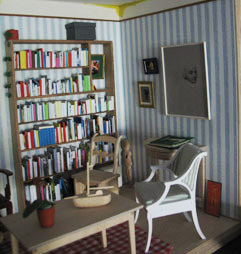
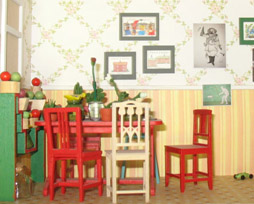
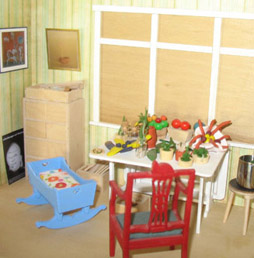
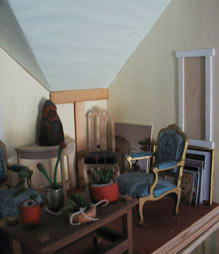
Interieurs need furniture: My favourite for models is Thorsten Lövgrens Kotte Toys - offering plywood-model kits of all kinds of chairs (and some other furniture) scaled 1:10 and 1:12 (see images above). Easy but also more difficult kits are available - and even models of the cow and horse from Björn Berg's illustrations of the Emil stories by Astrid Lindgren. And these can be used as skeleton for all kinds of animals and creatures. Used them on "my" Character Design-course at Malmö University, for example (see illustrations below). Note: cork-filling of forms to save on fimo and other bakeable modelling-mass is not recommended! It expands under heat and the figure's shell bursts...
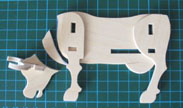

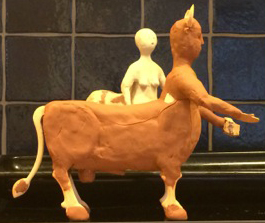
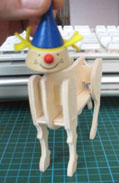
Characters express their typical traits or personality, specific moods in body language, facial expressions, in clothing and accessories (tools, guns, baggage, etc.). The examples below indicate style in clothing and choice of seat, but most of all they prove the cork-issue mentioned above... In the following I am not going to write in detail about body language, mimics, clothing etc., but about different puppets I use for experiments in character design and - of course - puppetry. Of course, body language is one of the crucial tools in puppetry, so always keep in mind that the puppet in play is using some of the mentioned areas, indeed!
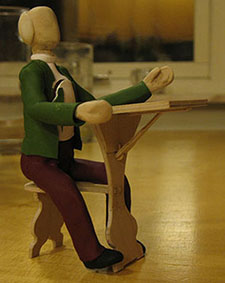
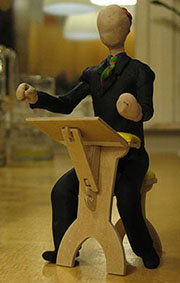
The following example of a glove-puppet is a neutral head, which can be individualised by adding different noses, eyes, or hair. These are held in place with double-faced tape or safety pins. When a specific figure is fully developed, the features could be glued to secure them in place, but the head would lose its adaptability, of course.


















All rather typical figures, those in the above. They need story to gain depth, a backstory to have more richness in details than their simple function in a play or story might ask for. With animals we refer to types much more freely and tolerate more standardised - "typical" - behaviour, presumably as we know these types from all those fables. They tend to lack individuality - and it is quite difficult to give individuality to an animal, if you try to design it kind of true to nature (oh, well...). The strength of these figures is their typicality, you can use them for great conversations, when you want to reduce complexity of explanations, for example. And: of course you can create individuality in the way you play them...
An important area within character design is the development of all kinds of figures for games, film, theatre, education, and comics. While all media have their distinct variation on the established genres, cross-medial narratives and re-tellings of established stories allow for new takes on the figures involved, too. The materiality and forms of production of each medium has consequences for how stories can be told, this can be used to freshen up older stories, but also to add detail to the narratives in other medial channels.
Figures like e.g. puppets can help wo allow people a fresh look at things: A lot of subjects can be introduced and discussed in a completely different way by putting an intermediary between the audience, focus group, etc. and the interviewer, teacher, campaigner etc. It also is much easier to ventilate thoughts by making a puppet say them, the puppeteer can pretend to just happen to stand behind it. Adult people tend to get irritated by being addressed by an animated figure or puppets at first, but most are able and willing to enter the playful special situation that is a conversation and interaction with an animated figure or a puppet. Children tend to be very interested in them, anyway. Here the lack of distance can even turn out to be a problem - but an abundance of strategies deals with this, of course.